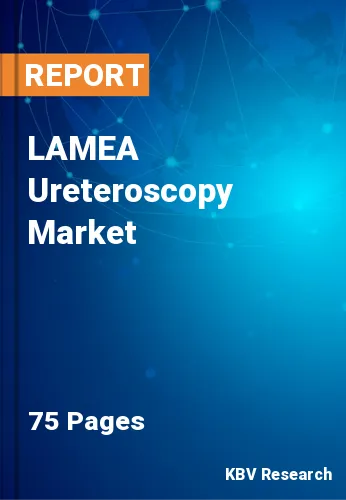The Latin America, Middle East and Africa Ureteroscopy Market would witness market growth of 7.4% CAGR during the forecast period (2022-2028).
In the ureter of some patients, a tiny temporary tube known as a stent is inserted. Given that the ureter may swell following the treatment, this stent makes it easier for urine to pass to the bladder. In addition, patients can have a urine catheter after surgery. This is a tube that is inserted into the bladder through the urethra. Urine can discharge from the bladder due to the catheter. After receiving treatment, patients will either go to the recovery room or their room, depending on the hospital's management.
The heart rate, blood pressure, and pain level will all be monitored regularly. Immediately following the procedure, the urinary catheter and/or stents are usually removed. Due to the rising prevalence of kidney stone-related diseases worldwide, the ureteroscopy market is projected to have significant expansion during the forecast period. The market is also expanding as a result of technological developments in flexible and semi-rigid ureteroscopes used to treat urolithiasis. When more novel ureteroscope devices are approved and released, it is projected that the market for ureteroscopes will grow dramatically.
The government of the United Arab Emirates (UAE) has made setting up a top-notch healthcare infrastructure a top priority. The prevalence of unhealthy lifestyles has increased, particularly among highly-paid populations. They increase the need for high-quality medical care. In order to satisfy the rising demand, the country's government is concentrating on building the necessary healthcare infrastructure. Also, the government is increasing infrastructure spending and encouraging the widespread use of new technology and gadgets in an effort to position the country as a center for medical tourism. As a result, the country offers better preoperative and postoperative care. These factors all point to sizable growth potential for the uretheroscopy market in the LAMEA region.
The Brazil market dominated the LAMEA Ureteroscopy Market by Country in 2021, and would continue to be a dominant market till 2028; thereby, achieving a market value of $17.1 Million by 2028. The Argentina market is experiencing a CAGR of 8% during (2022 - 2028). Additionally, The UAE market would display a CAGR of 7.1% during (2022 - 2028).
Based on End User, the market is segmented into Hospitals, Ambulatory Surgical Centers, and Others. Based on Product, the market is segmented into Flexible, and Semi- Rigid. Based on Application, the market is segmented Urolithiasis, Urinary Stricture, Kidney Cancer, and Others. Based on countries, the market is segmented into Brazil, Argentina, UAE, Saudi Arabia, South Africa, Nigeria, and Rest of LAMEA.
Free Valuable Insights: The Global Ureteroscopy Market is Predict to reach $1.1 Billion by 2028, at a CAGR of 5.2%
The market research report covers the analysis of key stake holders of the market. Key companies profiled in the report include Boston Scientific Corporation, Olympus Corporation, Hoya Corporation, Steris PLC, Stryker Corporation, Advin Health Care, Karl Storz SE & Co. KG, Richard Wolf GmbH, Cliniva Healthcare, and OTU Medical Inc.
By End User
By Product
By Application
By Country
Our team of dedicated experts can provide you with attractive expansion opportunities for your business.

